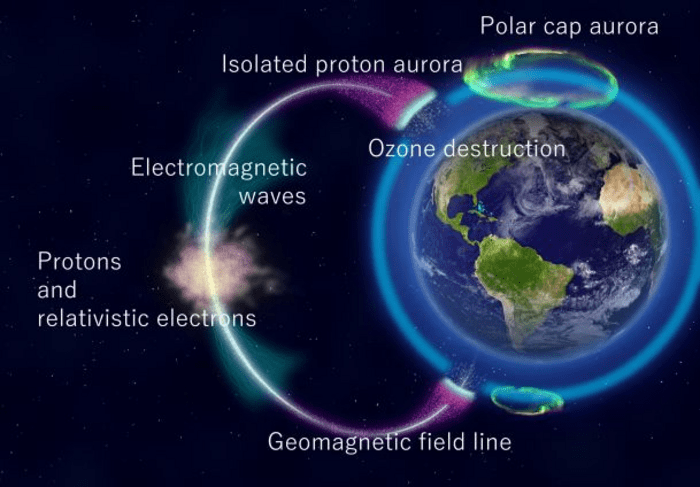Advanced life on Earth depends on the ozone layer, which shields us from lethal ultraviolet radiation. Yet even after nearly destroying this planetary armor and then saving it in the nick of time, there’s still a surprising amount we don’t know about it. One team of researchers found auroras can quite literally shed light on how it responds to bursts of space radiation.
Ozone is a molecule made up of three oxygen atoms. We have learned to our cost how easily ozone can be broken down by chlorine and similar chemicals, particularly in cold conditions high above the poles.
Atmospheric scientists know the same is true of high-energy plasma particles coming from the Sun or more distant sources, but the extent this happens has remained uncertain. New observations indicate our models have underestimated these particles’ impact.
The problem is thought to not primarily be the space particles themselves, but the way they ionize the atmosphere. All that excess charge produces nitrogen and hydrogen oxides, which can react with ozone.
The charged particles are hard to observe, but in their interactions with the upper atmosphere, they produce something far more obvious, and indeed beautiful: auroras. Auroras come in varying types but Dr Mitsunori Ozaki of Kanazawa University realized a specific sort known as an isolated proton aurora (IPA) could be our guide to tracking the damage space particles cause to ozone.
As their name suggests IPAs differ from other auroras by being separate from the main auroral belt. Although they take place at high latitudes, they occur further from Earth’s magnetic poles than ordinary auroras and are usually very localized and short. Although initiated by a burst of protons carrying more than 10 Mega electron volts from the Sun, the particles hitting the atmosphere are primarily electrons precipitated in Earth’s outer radiation belt and traveling close to the speed of light.

Isolated proton auroras are smaller than ordinary auroras and occur further from the geomagnetic poles and have now guided astronomers to a new source of ozone depletion. Image Credit: Kanazawa University
Ozaki and co-authors kept a lookout for IPAs using both the International Space Station and electromagnetic wave observations from the ground. They used the presence of IPAs as an indication of relativistic electron precipitation. They found that within 90 minutes of an IPA starting ozone concentrations in the mesosphere below had fallen by 10-60 percent.
Before anyone gets alarmed, or flying monkeys arrive to claim chlorofluorocarbons are now cleared of threatening Earth’s habitability, it is important to note the holes are about 400 kilometers (248 miles) across and heal quickly. The damage is restricted to the mesosphere, not the more important stratospheric component of the ozone layer. Even as solar activity rises over the course of the current cycle, there is no need for alarm.
The hydrogen oxides last only a few hours, their demise offering respite to the atmosphere. The nitrogen oxides get dispersed and cause longer lasting, but less intense, ozone depletion at high latitudes.
“This is the first observational study in the world to show that radiation belt electron fallout from space around the Earth has a direct, immediate, and localized effect on atmospheric changes in the mesosphere,” the researchers said in a statement.
“This study revealed that radiation belt electrons falling into the atmosphere from space around the Earth have a rapid and localized effect on the composition of the microatmosphere, including ozone.”
Perhaps dramatic events, such as a nearby supernova, could take these events to a problematic scale. For the moment, however, the significance of the discovery lies mostly in our increased capacity to understand the changes occurring within our atmosphere.
Source Link: Auroras Reveal 400-Kilometer-Wide Hole Briefly Punched In The Ozone Layer